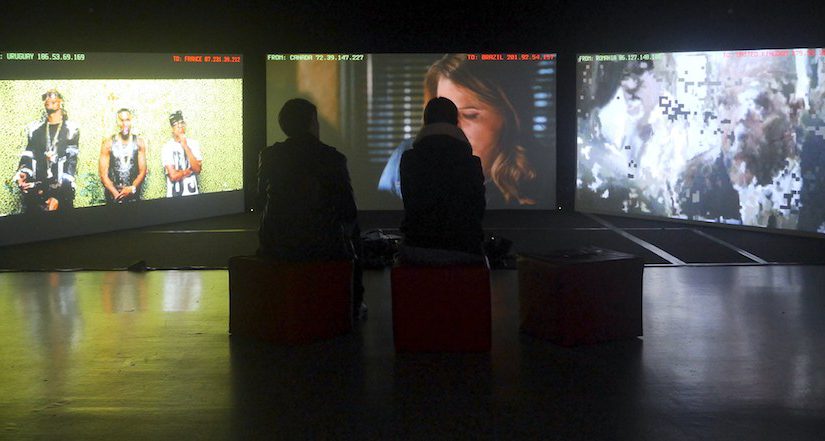
Video Installation
Nicholas Maigret
Photos: Justin Desforges, courtesy Nicolas Maigret
Image Credit: wired.com
Image Source: wired.com
The Pirate Cinema (2012) by Nicolas Maigret is an installation artwork featuring 3 screens, visualising how peer to peer data transfer in real time by using BitTorrent protocols. A collage of top 100 most popular transferred files are played across the 3 screens for a few seconds, including a brief flash of a partial IP address and location. Today, the artwork can be viewed online.
How it was created
Built on a data inception software, The Pirate Cinema automatically scans the most viewed torrents. The intercepted data is immediately projected onto the screen, and discarded after. Torrents scanned originates throughout the world.

Image Credit: piratecinema.com
In recent years, the availability of peer to peer sharing towards millions of internet users has heralded a new form of piracy, inadvertently changing the way how cinema is experienced. By exposing the ‘internal workings of media'[i], Maigret makes visible the limitations of peer to peer sharing with his immersive sensory and audio installation. Concurrently, he also highlights the possibilities of peer to peer sharing for being part of the aesthetic experience.
Relationship with the Third Space Network
The Pirate Cinema‘s foundations were built upon the third space, despite itself not being part of the medium, but rather, and extrusion of it. It becomes a visualisation of this abstract space, an amalgamation of the efforts of the collective user network engaged in torrenting (unknowingly). Akin to the 1970s and 1980s video collectives such as Videofreex and TVTV, which attempted to mobilise people to make their own medium rather than being passive consumers of a centrally constructed broadcast programming[i], The Pirate Cinema hosts the ordinary consumer (of networked data) into the role of the changed broadcast programming.
They attempted to democratize the media by facilitating people-to-people communication… activating the production of media around a proliferation of local issues expressed by a range of marginalized communities.
– Randall Packer, author of Third Space Network (2016)
Hence, the marginalised, passive consumers are able to break down the hierarchy in media information corporate structure, even-ing the grounds for communication. In fact, they are altered:
It is a living art, exploiting contemporary forms of digital and physical networks as a mode of open praxis…
– Marc Garett, co-director and co-founder of Internet art collectives and communities in Third Space Network
In fact, its existence as a living art can further contribute to the diversity of the artwork – with its ability to constantly rejuvenating itself based on the whims of the collective community, and free against the rules of the broadcast programming.
Ironically, despite of what it seeks to contravene, The Pirate Cinema‘s delivery emulates the centrally broadcast programming in the top down broadcasting to passive viewers. While its content might be drawn upon from the third space, its narrates its information through a screen – similarly, to passive viewers of the installation. Nevertheless, it remains a pivotal artwork in addressing the abstract realm of the third space, underlining the greater possibilities of the third space as an artistic platform and network.
References
[i] Packer R., “The Third Space Network” (2016)
[ii] “Aksioma — The Pirate Cinema By Nicolas Maigret”. Aksioma.Org, 2017, http://aksioma.org/pirate.cinema/.
[iii] Maigret, Nicolas. “Nicolas Maigret : Nicolas Maigret”. Peripheriques.Free.Fr, 2017, http://peripheriques.free.fr/blog/index.php?/projects/about/.

I appreciate your critical statement at the end, about how Pirate Cinema ultimately becomes a more traditional broadcast paradigm, due to the fact that the social nature of peer-to-peer broadcasting is reduced, as you say to a top-down broadcast. Interesting point, though I would say that it might be thought of as bottom up, since the network of users provide the content, essentially they are the broadcasters, while Pirate Cinema provides the platform for its dissemination to an audience, either local (installation) or online.